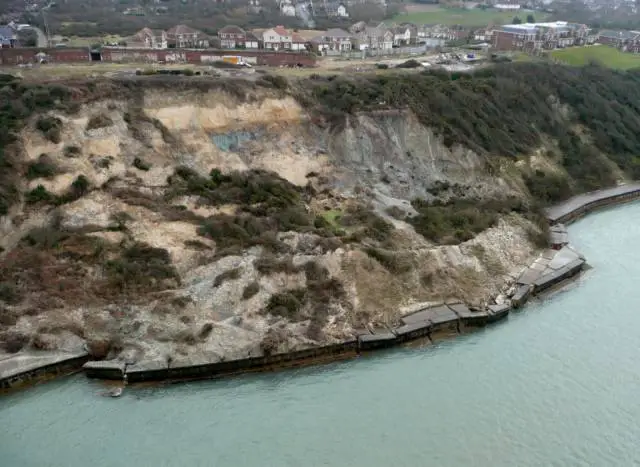At last night’s Scrutiny Committee, Executive member responsible for Fire and Rescue Services and Public Health/Safety, Cllr Phil Jordan, took questions from members of the Committee on proposals for Totland landslide.
Readers will remember the seawall at Totland suffered extensive damage following a landslip a year and a half ago in December 2012. A report into the failure of the sea wall was completed by consultants, Mott MacDonald, which sets out possible options to address the problem.
Next week, members of the Executive will be asked to make a decision to go ahead with one of four possible options.
Maintain the status quo
The first option is to effectively do nothing.
The area would remain fenced off from public use and the cost to the council for long-term maintenance of the fencing would be around £2,000 per annum.
Make and do mend
The second option is described as ‘make and do mend’ to prevent the damage worsening. The works are likely to include,
- sealing the gaps in the failed seawall, installation of steel sheet piles to prevent outflanking,
- re-positioning sections of failed seawall,
- importing crushed stone fill,
- drainage,
- extensive regrading works to the landslide, and construction of an unsurfaced footpath.
This option would see the pedestrian link between Totland and Colwell reinstated. The council estimate the cost associated with this option is between £175,000 and £200,000. Ongoing maintenance to ensure the footpath remains safe would add an estimated £10,000pa to the cost.
Full reconstruction
The third option is the ‘daddy of all options’, full reconstruction of the failed seawall, promenade and coastal slope estimated cost of over £2.4m.
The council may be able to obtain a grant from the Government for some of the costs (around a third was mentioned), but the costs involved in simply preparing the funding application etc, would be around £200,000.
Consider winter flood reports
The last option is focus on the further costing of Option 2, whilst taking into account a report that’s due in July 2014 into the flooding events during the 2012/13 winter.
As potential Government funding is up for grabs, this option would allow the council to be better informed on potential resource and cost implications before making a final decision.
Option four certainly looked to be the most obvious choice following last night’s scrutiny discussion.
Complexity of ‘scoring’ for funding
Cllr Whittle explained how Ryde, which has problems relating to winter flooding, has for five years been seeking to gain a ‘flooding score’ with the Government – that may lead to funding – but had not yet been successful. He explained that the ‘score’ related to how many homes were affected, how many people are involved and what the cost would be. The score then reveals the likelihood of whether or not funding could be achieved. It appears a complex area and one that is not easy to quickly grasp.
He asked Cllr Jordan how he felt the Totland area would fare. The Executive member replied that many of the properties are “so far back from the progression of the cliff edge” that it would be approaching 100 years before they were affected. He stressed that was not ‘all’ properties, as the NT fort is obviously much closer.
He confirmed that not having properties so close to the edge of the cliff worked against them in terms of the formula used by the Government to assess need for funding.
European funding
Harry Rees, town councillor for Ventnor, who sits on the Committee noted the Solent LEP was the only one of 39 LEPs that haven’t put a flood plan into the Government.
He also questioned why the council were not making any bids for a fund running in Europe for coastal erosion and coastal defences. He explained it had no strings attached and runs until 2010.
Cllr Stephens explained that the Solent LEP had chosen not to apply for the funding, but that he was speaking directly to Brussels.
Consider the tourist income and care homes
Cllr Whitehouse (Con) asked for members of the Executive to consider the impact to local businesses and knock-on effect to the wider community if nothing is done to address the problem.
He added that for many of the care home in the West Wight, the revetment was one of the only places by the coast that those in wheelchairs and using walking aids could use.
Members of the public are welcome to attend the meeting which starts at 6pm prompt on Tuesday 10th June at County Hall.
To see larger version, click on the full screen icon and the report will open in a new window.
Image: © HM Solent Coastguard





